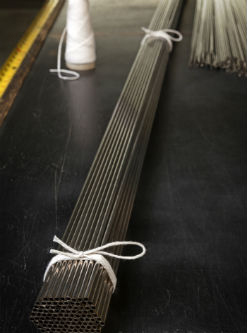Seamless High Nickel Alloys Pipes
Nickel alloy tubing is one of Koryo Steel specialties.
The addition of nickel adds unique characteristics to those alloys in which it comprises a large percentage of the element makeup.
Normally, nickel content is limited to 8-11% in most 300 series stainless steels, but in the alloys below it represents a much larger percentage of the components in each respective alloy.
Each of the high nickel alloys described below has unique characteristics which should be considered prior to purchase.
Tube Technology can form tubing in these alloys to sizes and tolerances within our manufacturable range.
All of our nickel alloy tubing is welded and drawn to size, custom manufactured to your specifications, and can be manufactured in tube lengths up to 30’. Gauge information regarding tubing sizes is available.
We also welcome custom alloy inquiries if you require a special alloy for your application.
X-750 Nickel Alloy Tubing
Alloy X-750 (UNS N07750) consists of approximately 70% nickel alloyed with chromium, iron and other select elements.
It has good strength at high temperatures approaching 1500 degrees F with high resistance to corrosion and oxidation.
Our X-750 inconel tubing is precipitation hardenable and is sometimes used in applications such as turbine parts, heat treating fixtures and combustion oxidizing environments.
Nickel Alloy 600 Tubing
Similar in makeup to X-750, Alloy 600 is composed of nickel content of approximately 72% and exhibits resistance to a wide range of corrosive sources, in part due to its chromium content.
Alloy 600 tube is also very effective in high heat environments approaching 2000 degrees F. It also demonstrates excellent resistance to high purity water.
Often, applications involve chemical, aerospace, heat exchanger, turbine parts or heat treating industries.
Nickel Alloy 52 Tubing
This alloy is comprised of 52% nickel, with the balance mostly iron. This unique alloy is most frequently used in glass to metal seal applications, ranging from light bulbs to specialty sensors, due to its similar coefficient of expansion to soft glass. With excellent formability, most of its applications are for industrial, sensor or lighting applications.
Cold Pilger
Cold pilgering also known as tube reduction or cold rolling is a process where a tube is cold-reduced by working it between a rocking set of dies on the outside and a hardened mandrel on the inside. In this process the hollow metallic tube is reduced along three dimensions: outer diameter, internal diameter and wall thickness, hospital reduction in these factors elongates the length of the tube further. In this process reduction rates of up to 50 – 60% are achieved in a single pass which is higher than the reductions achievable in the cold drawing process. During the cold pilger process seamless hollow undergoes high compressive residual stress thus attaining highest quality of finished tubes with superior surface finish, tight dimensional tolerances, and excellent machine-ability.
Cold Draw
Cold drawing is a metalworking process where the metal is stretched by using tensile forces at room temperature. In this process desired size of the tube is achieved by drawing it through a die which is smaller than the tube, elongating the length and reducing the diameter of the tube.
Cold drawing process enhances the quality of the tubes with smooth surface finish, precise dimensions and high strength. Machine used for drawing is called a draw bench. Shalco has this machine in various sizes in order to achieve smaller sizes. We carry out different cold drawing process at our plant such as:
1) Sink drawing
Sink drawing also known as hollow drawing is the simplest cold drawing procedure. In this process there is no mandrel inside the tube, so the tube is passed through a die of a smaller size and it is worked for a smoother polished surface. Only the outer diameter of the tube is reduced and not affecting the wall thickness to a great extent. During this process the inner surface is not pressurized so it can be further elongated using other cold drawing process.
2) Rod drawing
Rod drawing process reduces the outer diameter and inner wall thickness at the same time. In this process the tube is drawn with a mandrel inside the tube through the die. The hardened mandrel inside the tube when drawn through the die exerts pressure reducing the wall thickness and outer diameter. Size of the tubes depends upon the die and the mandrel.




